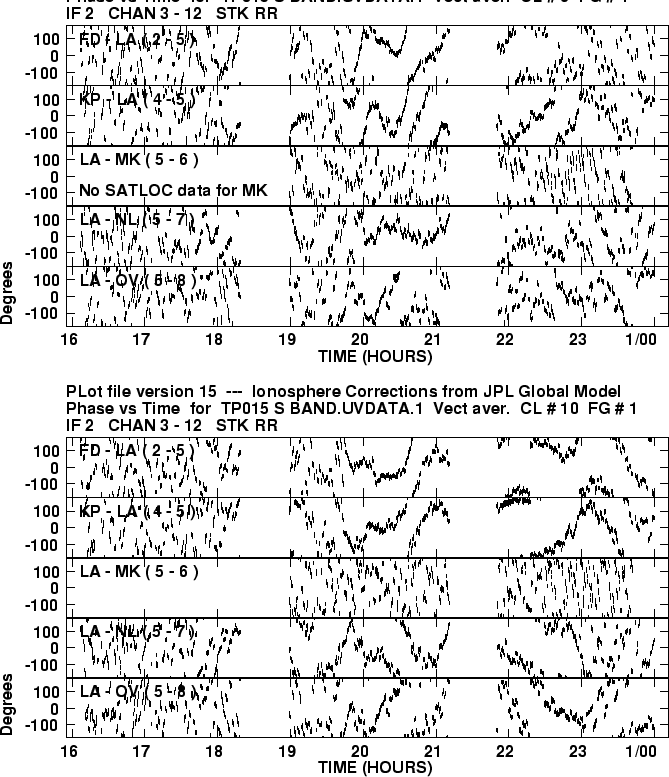Corrected Phases in TP015
Next: Direct Comparison of Delays Up: VLBA SCIENTIFIC MEMO 23 Previous: The Global Ionosphere Models
Corrected Phases in TP015
The results shown in Figure 2 show the effects of using some of the ionosphere determinations to calibrate 2.3 GHz data from TP015. The first panel shows the uncorrected raw phases from the VLBA correlator for 5 representative baselines to LA. Considerable phase variation is seen. The correlator uses a very accurate geometric model (CALC 9.0 for TP015 - since upgraded to 9.1) and we give it source positions good to about 0.1 mas and station positions good to around a centimeter. Thus pure geometric errors should amount to a small fraction of a turn of phase. On top of this, there may be errors in Earth orientation (including UT1, pole position, nutation) at the level of around a mas and the troposphere model could be in error by a few cm, increasing at low elevation. Finally the clocks are only modeled with a linear rate so any fluctuations of higher order will show up in the phases. But all of these effects should probably add up to a turn of phase or less across the day. Instead we see many turns.
 |
 |
The second panel of Figure 2 shows the phases corrected using the S/X ionospheric measurements. Now the phase variations indeed meet our expectations and it is clear that a good job has been done of removing the ionosphere. Note that the phases for all sources are shown in these plots. The short term scatter is the result of differences between the sources. It is much reduced if only one source is plotted. Note also that only one ionospheric value is determined per scan so, when there is a high fringe rate, the phase slope across the scan will still be seen in the corrected data. This is apparent in several places.
The results of calibrating the phases with the SATLOC regional model and with the JPL global model are shown in Figure 3 in the top and bottom panels respectively. Neither has flattened the phase slopes anywhere near as effectively as the S/X results. But the phase slopes have been reduced and, most importantly, the differences between sources have been significantly reduced. Note that the SATLOC model does not cover MK so that station is not corrected in the upper panel. MK corrections are derived based on the JPL model, but there are significant offsets between the S/X results and the model results for this station.
The phase plots demonstrate that the ionosphere does indeed cause large phase effects and that the S/X data can be used to remove them rather effectively. They also demonstrate that the GPS models improve the phases, including the relative phases between sources, but the corrections are not as good as those derived from the S/X data.
Next: Direct Comparison of Delays Up: VLBA SCIENTIFIC MEMO 23 Previous: The Global Ionosphere Models Craig Walker
2000-03-16




Connect with NRAO